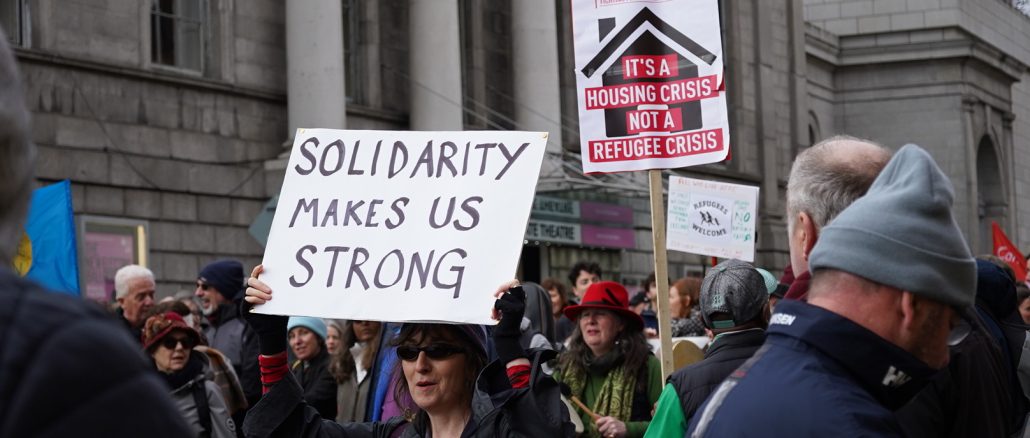
Slogans like #IrelandIsFull and #IrishLivesMatter have been sprawled across placards and waved at anti-immigration protests in Drimnagh, East Wall and Ballymun in recent weeks.
While their accusations are fuelled by racism and xenophobia, protesters have been using Ireland’s very real housing and homelessness crisis as justification for their claims. Protesters are concerned that immigrants are being given priority over Irish citizens regarding housing allocation. Counter-protesters believe that turning our backs on refugees is no solution and many are concerned by the quality of treatment received by asylum seekers in Ireland.
Amongst intensifying anti-immigration voices it is challenging to separate fact from hatred. Let’s examine the system for housing refugees and asylum seekers and determine whether Ireland has the capacity to effectively accommodate and support them.
Who are refugees and asylum seekers?
It’s important to distinguish the different categories of immigrants entering Ireland to identify how the government addresses each group. Protesters have taken to generalising or misusing terms to inflate their claims for the purpose of weaponization.
Migrants are people who have moved and are in the process of moving to another country. The term refers to all people moving to Ireland from other countries. Migrants do not immediately equate to refugees, rather, the term refugee is far more specific.
The United Nations Commissioner for Refugees defines the term as people “outside their country of origin who are in need of international protection.” The need for protection can be qualified by a serious threat to life or safety through persecution, violence and armed conflict. Similarly, asylum seekers are people who are in need and seeking international protection. These are individuals whose status as a refugee has not yet been determined by the state.
How many people are seeking asylum in Ireland?
Approximately 120,700 migrants entered the Republic of Ireland in 2022, the highest recorded figure since 2007. 13,319 of whom were asylum seekers from outside the European Economic Area (EEA), according to the Department of Justice. Over 52% of the applications made in 2022 were from four countries facing major conflict and internal strife; Georgia, Algeria, Somalia and Nigeria.
The figure for people applying for international protection in Ireland had already reached a record high before 70,000 people fled the war in Ukraine and were granted protection in 2022. The previously recorded peak for applications for asylum was seen in 2002 when 11,634 applications were made.
Currently, 39% of Ireland’s total Direct Provision occupancy are housed in Co. Dublin. The next county with the highest occupancy is Co. Cork at 6%.
How are asylum seekers being housed in Ireland?
Direct Provision is Ireland’s system of state-provided accommodation and other basic necessities for people seeking international protection.
Direct Provision was originally designed as short-term intermediary accommodation to be used while asylum seekers waited for their applications to be processed. Those in Direct Provision today are stuck in unsuitable accommodation for years as opposed to the previously assigned maximum of 6 months.
According to Nasc, an advocacy group for the rights of refugees and migrants in Ireland, the country has failed to provide safe, secure and appropriate accommodation for vulnerable individuals seeking safety through Direct Provisions.
Is Direct Provision regulated?
In 2015 the National Standards for Direct Provision was published. This framework lays out the requirements for emergency accommodation facilities to ensure individuals and families can have a suitable standard of living. This framework still applies to the over 45 Direct Provision centres currently in operation.
Each emergency accommodation should be a minimum size of 4.65m squared per bedroom per resident with a minimum ceiling height of 2.4m. Each residence should be homely, accessible, sufficiently furnished and tailored to the specific needs of its residents. The facilities required to live comfortably should be made easily accessible to the residents of those in emergency accommodations.
It is the responsibility of the individual service provider to ensure each accommodation fits the requirements set out by the National Standards for Direct Provision.
Has Direct Provision become a permanent fixture?
The need for direct accommodation has continued to increase with 1,132 people registered for the facility in January 2023 based on the International Protection Accommodation and Services monthly report. This increased stress placed on facilities sparked a need for an alternative solution.
In 2021 the Government committed to phasing out the Direct Provisions System by 2024.
The strain placed on the country’s emergency accommodation services to provide residence for those fleeing Ukraine has caused the timeline for the Government’s Plan to phase out Direct Provisions to be pushed out.
What alternatives have been proposed?
With help from an expert advisory group led by the former secretary general of the European Commission Catherine Day, the Government planned to achieve their goal of reducing time in Direct Provision with a proposed two-stage “blended” accommodation system.
Within this system, newly arrived asylum seekers would spend a maximum of four months in State-owned reception centres before moving into not-for-profit housing secured through approved housing bodies.
Following the influx of asylum seekers into Ireland this year, this proposed system was proven ineffective.
The expert group has advised the government to take specific actions in order to improve the state of emergency accommodations in Ireland and eradicate Direct Provisions.
The group report called on the government to take responsibility for the provision of social services such as emergency accommodation. The use of hotels and B&Bs as emergency accommodations has placed unnecessary stress on the hospitality sector in Ireland.
According to Ms Day and the expert advisory group, in order to alleviate pressure from the private hospitality sector and voluntary organisations the government needs to establish a State agency for the accommodation and integration of asylum seekers.
In recent statements, the Department of Integration and Equality urged refugees not to travel to Ireland, openly admitting to current capacity issues. While solutions may be long-term and costly, they are seemingly not being considered.
By Erin Murphy, Lisa Mullaly and Andrew Walsh
Image Credit: Hannah Giron Daygo
